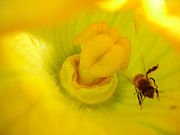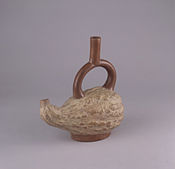Squash (plant)
| Squash(fruit) | ||||||||||||||
|---|---|---|---|---|---|---|---|---|---|---|---|---|---|---|
 Yellow squash
|
||||||||||||||
| Scientific classification | ||||||||||||||
|
| Summer squash Nutritional value per 100 g (3.5 oz) |
||||||||||||||||
|---|---|---|---|---|---|---|---|---|---|---|---|---|---|---|---|---|
| Energy 20 kcal 70 kJ | ||||||||||||||||
|
||||||||||||||||
| Percentages are relative to US recommendations for adults. |
||||||||||||||||
Squashes generally refer to four species of the genus Cucurbita native to the Mexico and Central America, also called marrows depending on variety or the nationality of the speaker. In North America, squash is loosely grouped into summer squash or winter squash, as well as autumn squash (another name is cheese squash) depending on whether they are harvested as immature fruits (summer squash) or mature fruits (autumn squash or winter squash). Gourds are from the same family as squashes. Well known types of squash include the pumpkin and zucchini. Giant squash are derived from curcurbita maxima and are routinely grown to weights nearing the size of giant pumpkins.
Archaeological evidence suggests that squash may have been first cultivated in Mesoamerica some 8,000 to 10,000 years ago [1][2], but may have been independently cultivated elsewhere, albeit later.[3] Squash was one of the "Three Sisters" planted by Native Americans. The Three Sisters were the three main indigenous plants used for agriculture: maize (corn), beans, and squash. These were usually planted together, with the cornstalk providing support for the climbing beans, and shade for the squash. The squash vines provided ground cover to limit weeds. The beans provided nitrogen fixing for all three crops.
Summer squashes, including young vegetable marrows (such as zucchini [also known as courgette], pattypan and yellow crookneck) are harvested during the growing season, while the skin is still soft and the fruit pretty much small, they are eaten almost immediately and require little to no cooking.
Winter squashes (such as butternut, Hubbard, buttercup, ambercup, acorn, spaghetti squash and pumpkin) are harvested at maturity, generally the end of summer, cured to further harden the skin, and stored in a cool place for eating later. They generally require longer cooking time than summer squashes. (Note: Although the term winter squash is used here to differentiate from summer squash, it is also commonly used as a synonym for Cucurbita maxima.) The squash fruit is classified as a pepo by botanists, which is a special type of berry with a thick outer wall or rind formed from hypanthium tissue fused to the exocarp; the fleshy interior is composed of mesocarp and endocarp. The pepo, derived from an inferior ovary, is characteristic of the Squash Family (Cucurbitaceae).
In addition to the fruit, other parts of the plant are edible. Squash seeds can be eaten directly, ground into paste, or (particularly for pumpkins) pressed for vegetable oil. The shoots, leaves, and tendrils can be eaten as greens. The blossoms are an important part of native American cooking and are also used in many other parts of the world.
Contents |
Pollination

As with all other members of the family, the flowers come in pollen-bearing male form, and the ovary-bearing female form, with both forms being present on the plant. Squash has historically been pollinated by the native North American squash bee Peponapis pruinosa, and related species, but this bee and its relatives have declined, probably due to pesticide sensitivity, and most commercial plantings are pollinated by European honey bees today. One hive per acre (4,000 m² per hive) is recommended by the US Department of Agriculture. Gardeners with a shortage of bees often have to hand pollinate. Giant squash grown competitvely are usually hand pollinated. Flowers are kept closed before and after pollination to prevent cross polination. Inadequately pollinated female squash flowers will usually start growing but abort before full development. Many gardeners blame various fungal diseases for the aborted fruit, but the fix proves to be better pollination not fungicide.
In cooking
Though considered a vegetable in cooking, botanically speaking, squash is a fruit (being the receptacle for the plant's seeds).
Etymology
The English word "squash" derives from askutasquash (a green thing eaten raw), a word from the Narragansett language, which was documented by Roger Williams, the founder of Rhode Island, in his 1643 publication A Key Into the Language of America. Similar words for squash exist in related languages of the Algonquian family such as Massachusett.
Use as an object of art

The squash has been an essential crop in the Andes since the pre-Columbian Era. The Moche culture from Northern Peru made ceramics from earth, water, and fire. This pottery was a sacred substance, formed in significant shapes and used to represent important themes. Squash are represented frequently in Moche ceramics. [4]
References
- ↑ Archaeobiology: Squash Seeds Yield New View of Early American Farming
- ↑ The Initial Domestication of Cucurbita pepo in the Americas 10,000 Years Ago
- ↑ Eastern North America as an independent center of plant domestication
- ↑ Berrin, Katherine & Larco Museum. The Spirit of Ancient Peru:Treasures from the Museo Arqueológico Rafael Larco Herrera. New York:Thames and Hudson, 1997.
External links
- Squash Display at Missouri Botanical Garden - Pics of 150 varieties from The Great Pumpkin Patch
- Squash Display at Missouri Botanical Garden - * [2] - Master Gardeners: McClellan Ranch 2003 Squash Varieties